What is MAC filtering?
Strengthening Cybersecurity: Exploring the Importance of MAC Filtering in Network Access Control.
"Media Access Control (MAC) filtering is a security technique used in intranet and computer systems. This technique controls the process of devices communicating on a network by enacting a network protocol that uses hardware or physical addresses. MAC filtering is a critical measure undertaken to safeguard network infrastructures as it provides added protection to authentication processes and encryption protocols, and proves vital in avoiding unwanted access and threats that could compromise interconnected systems.It's essential to comprehend that every device connected to a network leverages an internet protocol (IP) address, but also a unique MAC address. Unlike IP addresses that may change based on network changes, the MAC address is inextricably linked to the device's network interface card (NIC) located within the device’s hardware and remains static regardless of external configuration changes. The MAC address often acts as the device's identity when connected to a network.
MAC filtering functions by implementing an access control method that allows or denies network access to devices based on their MAC addresses. There are two types – a whitelist or a blacklist. In whitelist mode, only devices differing this unique dependable identifier known MAC addresses are allowed access to the network, while all others are denied. Conversely, with blacklist mode, known hazardous MAC addresses are denied access to the network, whereas all other devices can connect freely.
The potential benefits of this technique towards enhancing cybersecurity are multiple. Environments that are susceptible to unauthorized network access or any other type of hostile intrusion can leverage MAC filtering to provide an added layer of security. Possible unauthorized access to data, theft of sensitive information and disruption of services can be dramatically reduced with MAC filtering properly employed. It offers a sort of first-line defense measure against hostile elements on the network.
MAC filtering serves an especially critical function in organizations that deal with sensitive information where secure access is a priority. It can assist in creating a robust and secure network by ensuring that only trusted devices gain access. Antivirus software and firewall settings can offer protection from threats such as malware or spam, but they may fail to provide the first level of defense against unauthorized device access to the network - which MAC filtering can provide.
Despite the evident merits of MAC filtering in network security, this method does not stand impervious to cyber threats. Skilled hackers with the right tools might spoof MAC addresses, thereby slipping past this security measure. Spoofing involves creating a network identity, by manipulating a device’s MAC address, mimicking a whitelisted device, and deceiving filters into allowing access. Therefore, although MAC filtering presents a valuable supplement to a robust cybersecurity protocol, it should not be solely relied upon.
It's vital not only to perform MAC filtering in a sensible and calculated manner, but it's equally critical to ensure measures such as firewalls, secure sockets layer (SSL) certificates, IP filtering and data encryption are utilized concurrently. Modern antivirus software can provide total network security solutions, with features embracing MAC filtering but extending it to comprehensive preventative strategies such as detection systems for intrusion, automated security checks, firewall management, email protection and ransomware protection.
MAC filtering, while a useful security feature, should not stand alone in any cybersecurity strategy. Instead, it should function as an important tool in a multifaceted approach to network security, which includes anti-virus software, firewalls, and regularly updated security protocols. By integrating broader cyber solutions with precision-based controls like MAC filtering, entities can protect data and connectivity more securely, creating a robust, hardened defense against the ever-evolving threats in modern network systems."

MAC filtering FAQs
What is MAC filtering in cybersecurity and antivirus?
MAC filtering is a security feature used to limit access to a network by allowing or denying access based on the Media Access Control (MAC) address of the device.How does MAC filtering work?
MAC filtering works by creating a list of MAC addresses that are authorized to access the network. If a device with an unauthorized MAC address attempts to connect to the network, it will be denied access.Is MAC filtering an effective cybersecurity measure?
MAC filtering can provide an additional layer of security for a network, but it should not be relied on as the sole security measure. It can be circumvented by spoofing the MAC address of an authorized device, so it should be used in conjunction with other security measures such as strong passwords and encryption.How do I enable MAC filtering on my network?
The process for enabling MAC filtering varies depending on the type of router or network device you have. Generally, you will need to access the router's settings and create a list of MAC addresses that are permitted to access the network. Consult your router's manual or online documentation for specific instructions.| | A | | | B | | | C | | | D | | | E | | | F | | | G | | | H | | | I | | | J | | | K | | | L | | | M | |
| | N | | | O | | | P | | | Q | | | R | | | S | | | T | | | U | | | V | | | W | | | X | | | Y | | | Z | |
| | 1 | | | 2 | | | 3 | | | 4 | | | 7 | | | 8 | | |||||||